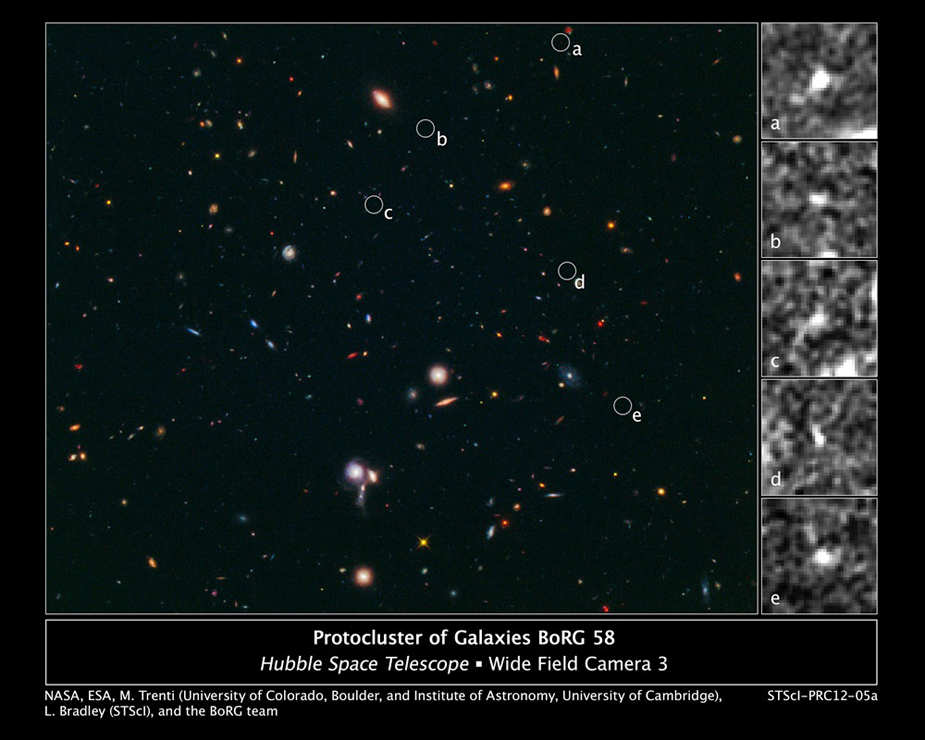

NASA's Hubble Space Telescope has uncovered a cluster of galaxies in the initial stages of construction –– the most distant such grouping ever observed in the early universe. An astrophysicist at UC Santa Barbara contributed to the discovery.
In a random sky survey made in near-infrared light, Hubble spied five tiny galaxies clustered together 13.1 billion light-years away. Among the brightest galaxies at that epoch, they are very young, living just 600 million years after the universe's birth in the Big Bang.
Galaxy clusters are the largest structures in the universe, comprising hundreds to thousands of galaxies bound together by gravity. The developing cluster, or protocluster, presumably will grow into one of today's massive galactic cities, comparable to the nearby Virgo cluster, a collection of more than 2,000 galaxies.
"Just a couple of years ago, a discovery like this one would have seemed impossible," said Tommaso Treu, team member and a professor of physics at UCSB. "Now, we are not only finding galaxies as close as ever before to the Bang Bang, but we are actually finding entire structures of them!"
The study's leader, Michele Trenti, added: "These galaxies formed during the earliest stages of galaxy assembly, when galaxies had just started to cluster together. The result confirms our theoretical understanding of the buildup of galaxy clusters. And, Hubble is just powerful enough to find the first examples of them at this distance." Trenti is affiliated with the University of Colorado at Boulder and Britain's Institute of Astronomy at the University of Cambridge.
Trenti presents his results today at the American Astronomical Society meeting in Austin, Texas. The study is published in the Jan. 10 issue of The Astrophysical Journal.
Most galaxies in the universe live in groups and clusters, and astronomers have probed many mature galactic cities in detail, as far away as 11 billion light-years. But finding clusters in the early phases of construction has been challenging because they are rare, dim, and widely scattered across the sky.
Last year, a group of astronomers uncovered one distant developing cluster. Led by Peter L. Capak of NASA's Spitzer Science Center at the California Institute of Technology in Pasadena, the astronomers discovered a galactic grouping 12.6 billion light-years away with a variety of telescopes, including Hubble. Spectroscopic observations were made with the W.M. Keck Observatory in Hawaii to confirm the cluster's distance by measuring how much its light has been stretched by the expansion of space.
Trenti's team used Hubble's sharp-eyed Wide Field Camera 3 to hunt for the elusive catch. "We need to look in many different areas, because the odds of finding something this rare are very small," said Trenti. "It's like playing a game of Battleship: The search is hit and miss. Typically, a region has nothing, but if we hit the right spot, we can find multiple galaxies."
Because these distant, fledgling clusters are so dim, the team hunted for the systems' brightest galaxies. These brilliant light bulbs act as billboards, advertising cluster construction zones. Galaxies at early epochs don't live alone. From simulations, the astronomers expect galaxies to be clustered together. Because brightness correlates with mass, the most luminous galaxies pinpoint the location of developing clusters. These powerful light beacons live in deep wells of dark matter, which form the underlying structure in which galaxy clusters form. The team expects many fainter galaxies not seen in these observations to inhabit the same neighborhood.
The five bright galaxies spotted by Hubble are about one-half to one-tenth the size of our Milky Way, yet are comparable in brightness. The galaxies are bright and massive because they are fed lots of gas through mergers with other galaxies. The team's simulations show that the galaxies will eventually merge and form the brightest central galaxy in the cluster, a giant elliptical galaxy similar to the Virgo Cluster's M87.
The observations demonstrate the progressive buildup of galaxies and provide further support for the hierarchical model of galaxy assembly, in which small objects accrete mass, or merge, to form bigger objects over a smooth and steady but dramatic process of collision and agglomeration. The process is similar to that of streams merging into tributaries, then into rivers, and then to bays.
Hubble looked in near-infrared light because ultraviolet and visible light from distant objects have been stretched into near-infrared wavelengths by the expansion of space in these extremely distant galaxies. The observations are part of the Brightest of Reionizing Galaxies (BoRG) survey, which is using Hubble's Wide Field Camera 3 to search for the brightest galaxies around 13 billion years ago, when light from the first stars burned off a fog of cold hydrogen in a process called reionization.
The team estimated the distance to the newly spied galaxies based on their colors, but the astronomers plan to follow up with spectroscopic observations to confirm their distance. Treu is leading the spectroscopic follow-up of these protocluster galaxies using the 10-meter W.M. Keck Telescope.
The first paper on the spectroscopic follow-up led by Treu will be published in the Feb. 1 issue of The Astrophysical Journal. Treu plans to extend the spectroscopic follow-up with MOSFIRE, a next generation instrument about to be commissioned on the Keck Telescope. "These protocluster galaxies are the ideal targets for MOSFIRE, an instrument capable of measuring infrared spectra for several objects at once," said Treu. "In combination with the Hubble images, Keck spectra will provide more accurate measurements of the distance and motion of these galaxies, as well as the way in which stars form and reionize the universe around this time."
† Top image: Hubble Spies Building Blocks of Most Distant Galaxy Cluster
The composite image at left, taken in visible and near-infrared light, reveals the location of five tiny galaxies clustered together 13.1 billion light-years away. The circles pinpoint the galaxies.
The sharp-eyed Wide Field Camera 3 aboard NASA's Hubble Space Telescope spied the galaxies in a random sky survey. The developing cluster is the most distant ever observed. The young galaxies lived just 600 million years after the universe's birth in the Big Bang.
The average distance between them is comparable to that of the galaxies in the Local Group, consisting of two large spiral galaxies, the Milky Way and Andromeda, and a few dozen small dwarf galaxies.
The close-up images at right, taken in near-infrared light, show the puny galaxies. The letters "a" through "e" correspond to the galaxies' location in the wide-field view at left. Simulations show that the galaxies will eventually merge and form the brightest central galaxy in the cluster, a giant elliptical similar to the Virgo cluster's M87.
Galaxy clusters are the largest structures in the universe, comprising hundreds to thousands of galaxies bound together by gravity. The developing cluster presumably will grow into a massive galactic city, similar in size to the nearby Virgo cluster, a collection of more than 2,000 galaxies.
Credit: NASA; ESA; Michele Trenti, University of Colorado at Boulder and Britain's Institute of Astronomy at the University of Cambridge; Larry Bradley, Space Telescope Science Institute, Baltimore; and the BoRG team including Tommaso Treu, UC Santa Barbara.
Related Links



